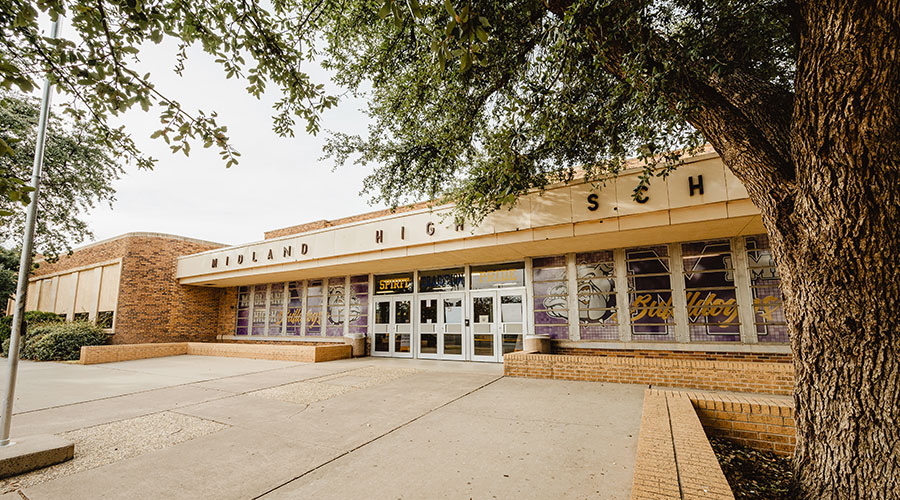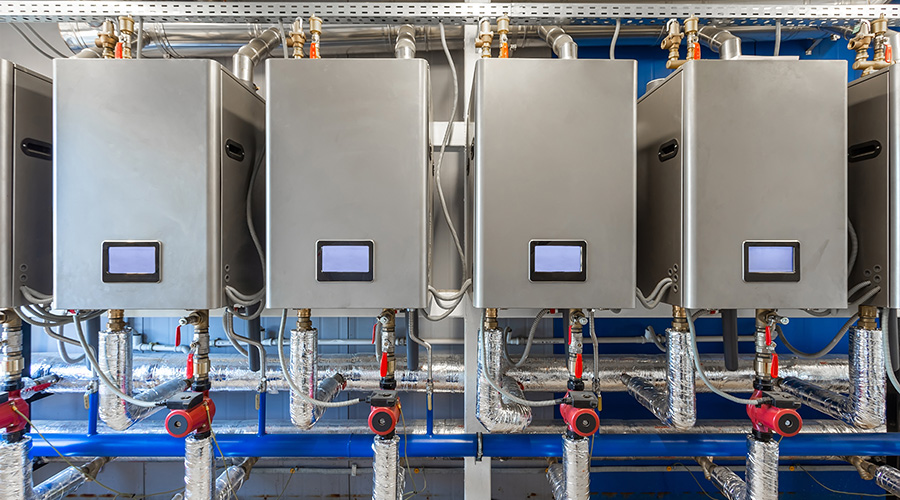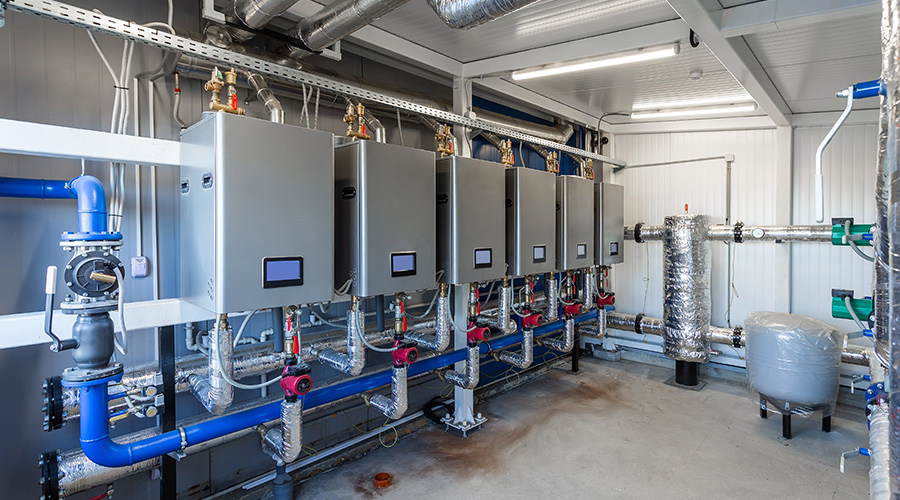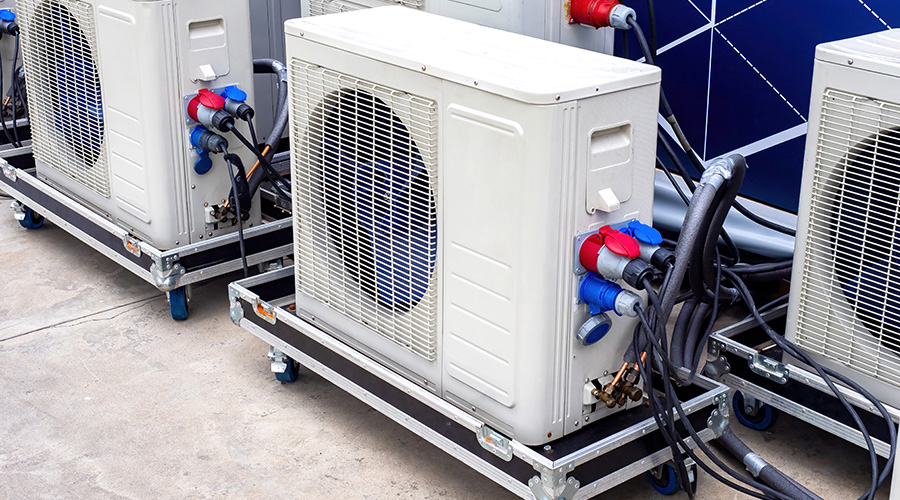Slow Pace Of HVAC Change Means Missed Gains
A range of HVAC technologies and design strategies are being used far less often than their track records and potential savings would justify
Energy technologies used in buildings have advanced rapidly over the past decade. Although no wholly new HVAC technologies have appeared in that period, many options have improved, become more reliable or dropped in cost. Still, many HVAC technologies that could cut operating costs, such as variable-speed drives and energy management systems, remain underused.
With an understanding that what’s new for one customer may be old hat to another, here’s a brief shopping list of options.
More Efficient Central Cooling Systems
Electric chillers — complete with variable-speed drives, oversized heat exchangers, hot gas bypass control, to name a few features — have redefined efficiency from a “good” .7 kw/ton in 1990 down to about .5 kw/ton or better, cutting power demand and consumption almost 30 percent. Gas-fired reciprocating or double-effect absorption cycle chillers replace demand for electricity with use of natural gas. Thermal storage systems have become modular and more reliable, allowing them to fit into spaces with only marginal real estate value. Where electricity is expensive year-round, “free” cooling using cooling tower condenser water is no longer uncommon.
Rooftop and packaged units containing compressors and fans have become significantly more efficient, mostly as a result of changes to product efficiency standards mandated by the 1992 federal Energy Policy Act. Improvements of 20 to 30 percent are now common. Heat pumps and window air conditioning units are 10 to 15 percent better than they were only a decade ago.
Better HVAC Distribution Options
Those same federal standards raised minimum efficiencies for fan and pump motors and now require variable-speed drives on smaller units. VAV fans down to 30 horsepower must now be able to run efficiently at lower loads.
Although not necessarily designed purely for energy efficiency purposes, underfloor air distribution and radiant cooling systems, as well as dedicated outside air systems, are becoming more accepted as their reliability improves and their installation costs drop.
Economizer cycles, which replace return air with outside air when it is cooler, and air-to-air heat exchangers, sometimes called displacement systems, have been around for decades, but are now required by code for many new air system designs.
More Controls Clout
A variety of sophisticated control systems are also either required or accepted to meet building codes for new construction. A good list can be found in the changes made between ASHRAE’s 90.1-1989 standard and its 90.1-1999 version, which is now part of the federal standard that all states are supposed to adopt as part of their own building codes by mid-2004. Among those options to meet code are:
- Automatic ventilation controls for high-occupancy areas, including variable outside air volume based on carbon dioxide monitoring.
- Zone and loop controllers incorporating control error correction, plus a deadband when separate thermostats control heating and cooling in a zone; doing so limits reheating and recooling done by separate systems.
- Automatic shutoff controls for the supply of conditioned air, outside air and exhaust air to each zone, as well as automatic shutdown controls for off-hour operations or only minimal flow to maintain temperature.
- Motorized dampers in stair and elevator shafts and outdoor air supply exhaust hoods, vents and ventilators to minimize updrafts and infiltration.
- Resettable chilled and hot water temperatures in smaller systems —over 300,000 Btuh instead of the previous 600,000 Btuh.
Potential Savings
Although savings will vary greatly depending on climate, energy pricing, and building type and age, analyses by the U.S. Department of Energy indicate that applying just the relevant HVAC aspects of the 1999 ASHRAE code to America’s stock of buildings could yield savings of about 2 percent on electric usage, almost 3 percent on gas, and about 2 percent on overall energy bills, relative to present consumption. Comparing that to pre-1989 code buildings as a base, another 2 to 3 percent — for a total of about 5 percent — could be taken off annual energy bills for all U.S. non-residential buildings.
At first blush, that may not seem like a lot, but those numbers are based on the total building stock in the United States. A simplified calculation for a 160,000-square-foot office park in a mid-Atlantic climate finds its energy and dollar savings ranging from 8 to 15 percent, relative to the same facility being built before the 1989 standard came into play. In rough dollars, that boils down to about 15 to 35 cents per square foot per year, roughly comparable to many high-efficiency lighting upgrades.
Despite the range of choices, their proven track records and the potential savings, there has been no rush to take advantage of the newer technologies and designs. Why? There are several reasons.
One is that taking on any new technology involves a learning curve and some risk of failure or inconvenience. In the absence of an in-house champion for energy cost cutting, there may be no one to make the case that upgrading HVAC systems will make much financial difference.
Experience also shows that, for every one person willing to say “yes” to energy efficiency, there are 10 who say “no.” The first items to be value engineered out of a building’s mechanical design, for example, are often energy efficiency options that are not needed to make the overall system work acceptably.
In one major Northeastern institution, building operators resisted changing out their single-stage absorption chillers, fed by expensive utility steam, for a hybrid electric and gas-fired absorber plant because of a lack of knowledge and training on the new system.
In another case, word-of-mouth stories about how some new technologies were problematic or did not deliver expected savings were enough to block consideration of newer versions that had acceptable track records.
Many dyed-in-the-wool HVAC practitioners show little interest in learning about new technologies. Such technical inertia may stem from an attitude that says all hours of personnel time should be allocated to an existing job, so only a request from a customer to consider a new option will result in an investigation. An increasingly litigious culture also creates a financial risk when specifying, designing or installing anything not already tried-and-true.
Problems may also occur during adjustment of a base building design to accept new devices that, to be more efficient, are larger than originally called for or are unavailable in sizes needed to accommodate existing or projected needs. One customer wanted to install exhaust air heat exchangers in a lab building, but doing so would have required changing the setback on the floor containing the air handlers, which would have disrupted the building’s appearance.
Many new systems involve longer lead times for delivery that are unacceptable in tight building construction schedules. If a device is not readily available, whatever is on the shelf at the local supply house may be installed instead.
The incrementally higher cost of some new systems — including design, installation and commissioning — may also stand out more than potential savings, which typically take years to cover. Any possibility of selling the building during that time period creates uncertainty about recouping those extra costs.
For existing buildings, installing a new system may require alteration or contact with other systems or spaces that could create new problems. High-efficiency motors, for example, may require replacement of old circuit breakers unable to accommodate their higher in-rush current. If those power panels are touched, that may require upgrading them to meet new electrical codes, resulting in disruption and higher costs.
Some complex options, such as cogeneration, are very sensitive to changes in utility rates, thus creating significant financial risk for developers and building owners. Such fears lead to a wait-and-see attitude that is often the kiss of death.
Finally, the method to calculate savings from such new devices may be outdated or too narrow. Where average power pricing is used instead of a computer model that takes time-of-use costs into account, savings could appear lower than may actually occur. In other cases, savings or credits that should be taken are left off the balance sheet. When an electric chiller was to be replaced with a gas-fired unit, for example, a significant drop in a building’s peak electric demand would have resulted, allowing for installation of new power-consuming devices like a mainframe computer without a need to beef up the transformer or main electric service capacity. That large avoided cost was not included in the payback analysis for the chiller changeout, yielding an unacceptably long payback period.
No Pressing Need
Another reason that more efficient HVAC technologies haven’t been adopted more quickly is the absence of factors that make energy upgrades a higher priority within corporations. In many parts of the country, for example, energy prices were relatively stable for most of the 1990s, eliminating a major impetus for upgrading HVAC systems.
In other cases, a developer has no concern for the operating cost of the building because the occupants will pay the energy bills. Any additional cost may even make the structure harder to sell.
In roughly a third of states, energy codes either do not exist or are so poorly enforced that contractors know there is essentially no reason to comply with them. The increase in demand for fire and electric code inspections has swamped many jurisdictions, leading them to drop inspections or reviews for such non-safety issues as energy. Until the adoption of ASHRAE 90.1-1999 in 2004, most energy codes apply only to new buildings, allowing renovations, which affect the lion’s share of buildings, to escape coverage.
When most utility-sponsored energy rebates were dropped in the late 1990s as a result of power industry restructuring, many companies lost interest in pursuing the options once supported by such “free” money.
Weak Codes
Building codes are another impediment to wider adoption of newer HVAC technology and design. Although some states have excellent energy standards built into new construction building codes, and some have extended their coverage to major renovations, most states either have no code or are still using a code based on ASHRAE 90.1-1989, which is now out of date. All states were to have deployed codes adopting the 1989 standard or something equivalent to it by the mid-1990s. But fully a third of them never did, despite a federal law requiring such action.
By July 2004, all states are required to adopt standards in their energy and building codes that mirror ASHRAE 90.1-1999. California, Oregon, New York and others have already moved past that standard and are using ASHRAE 90.1-2001 as a benchmark. It is unclear, however, if the new code requirement will be better enforced than the old one.
If there is ever to be a serious reduction of energy waste, it appears that enlightened compliance, especially for renovation projects, is a necessary part of that effort. Educating both practitioners and facility executives will be essential to overcoming the many barriers to success.
Many Factors Slow the Rate of Technology Adoption
Why the relatively slow pace of change for HVAC systems? The reasons vary from one region of the country to the next and one sector of the economy to another. Taken together, however, those factors have combined to slow the application of advanced HVAC options.
Choices that make sense in areas with high energy costs may not make sense in places where power and fuel supplies have, in the last decade, been relatively cheap and stable. Likewise, some technologies are more easily adopted as part of new construction (e.g., thermal storage) than as part of a minor renovation. As a result, they are often seen more frequently where economic growth is happening. Even the structure of electric tariffs can strongly influence the choice of an electric chiller, for example, over a gas-fired unit. Finally, the presence of utility rebates or other financial incentives tends to skew acceptance of new devices.
|
| |
A Closer Look At State Energy Codes
For details on the requirement for state codes to meet the 1999 standard, go to www.energybuyer.org/julytip2003.htm. Determine the status of a state’s relevant energy or building code.
The positive impact of the codes is heavily influenced by whether they cover only new construction or also apply to major renovations. In its analysis of such impacts, the DOE’s quantitative analysis concluded:
“...the 1999 revision of the code would likely reduce the source energy consumption of new commercial buildings by approximately 5.9 percent. Site energy savings were estimated to be approximately 3.9 percent. . . . The dominant factor in this comparative analysis is the 1999 edition’s inclusion of alterations and renovations to existing buildings. If the value of annual investment in building alterations and renovations is a good indicator of their impact on energy use, then the expansion of this code to existing buildings could produce nearly 50 percent more savings than if it were applied to new buildings alone.”
Full text available.
|
Related Topics:











